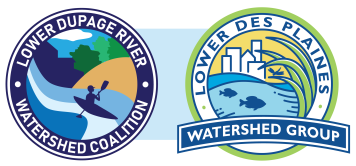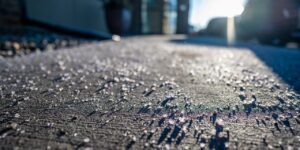Road salt is an important tool to keep our roads safe during winter weather. It can speed up snow and ice melting, making it easier for plows to clear the roadways. Over 428,000 tons of road salt was used on Illinois roads during in the winter of 2019-2020. While salt is important for safe winter roads, excess salt use can hurt our local waterways.
Why should we care about too much road salt?
Salt, or sodium chloride, is very water soluble, meaning it easily dissolves in water. This is why it is effective at melting snow and ice. However, this also means it can easily impact the water quality of nearby rivers and streams. A single teaspoon of salt is enough to contaminate five gallons of water. Once salt dissolves it does not degrade overtime. In fact, salt is very challenging and costly to remove from water, essentially making it a permanent pollutant.
Too much salt in our water has environmental impacts. High chloride concentrations can impact local aquatic life, like fish, insects, and freshwater mussels, by inhibiting their ability to successfully reproduce and survive in our local waterways. Even at chloride concentrations as low as 150 mg/L (about ½ teaspoon of salt in 5 gallons of water), local watershed groups have documented impacts to aquatic communities.
High salt concentrations also affect plants. Road salt can kill plants, like grass next to sidewalks and trees along our roadways. It can impact the soil along our roadways making it difficult for plants to grow. It can be costly to repair and replace the “salt burned” plants and very difficult to neutralize the impacts of chlorides in soil. Aquatic plants are impacted too—high salt concentrations can lead to a die-off of native aquatic plant species.

High concentrations of salt in our drinking water impact people too. We begin to taste salty water when the concentrations are above 250 mg/L, which is the drinking water standard for chloride. Too much salt in our water can lead to health problems for those who need low-sodium diets.
Salt is also corrosive. It causes damage to our bridges, roads, vehicles, and building entryways. Also, high chloride concentrations in drinking water can damage metal pipes.
What is being done about salt pollution?
In Illinois, the water quality standard for chloride is 500 mg/L. There are several regulatory tools to help address the environmental impacts for waterways that are above the water quality standard. Two of these tools are TMDLs, total maximum daily load, and a variance approach.
A TMDL, or total maximum daily load, is used when a waterway is shown not to support one or more of its designated uses. TMDLs set specific pollution reduction goals to improve the waterways for their designated uses and take a watershed-wide approach to reducing the pollutant. Some of the local waterways with a chloride TMDL include the DuPage River and the North Branch of the Chicago River.
A variance approach is similar to a TMDL, but operates a little bit differently. A variance to the current chloride water quality standard can be granted by the Illinois Pollution Control Board. This allows for a specified amount of time to address the high chloride concentrations without being subjected to the current standard. This gives communities time to implement better winter maintenance practices that maintain winter road safety while reducing salt use. The variance approach for a pollutant like chloride works best as a watershed-wide approach where communities work together to make chloride reductions while still maintaining safe roads. Currently, there is a chloride variance petition up for approval by the Illinois Pollution Control Board for the Chicago Area Waterways System, which covers much of the City of Chicago and the south suburbs, and a portion of the Lower Des Plaines River Watershed.


What are communities doing about salt pollution?
Many communities use improved winter maintenance practices to provide safe roads, while reducing the amount of salt they use to reduce their impact on local waterways regardless of regulatory requirements.
Communities implement practices like anti-icing (which uses a quarter of the amount of salt compared to de-icing!) to make it easier to plow snow and ice from our roads. Anti-icing prevents snow and ice from sticking to the pavement in the first place. They train their staff on these improved winter maintenance practices. They work to upgrade their good housekeeping techniques to help reduce excess salt runoff at their facilities.
Communities also get residents involved. Public education goes a long way to reduce salt use on home driveways and make small changes like working from home during a snowstorm or building in extra time to their commute so they can give plow drivers a chance to get the roads cleared.
Finally, many communities participate in watershed workgroups to learn from each other and work together to improve our local waterways. By coming together, we can make greater gains to protect rivers and streams across our region.




